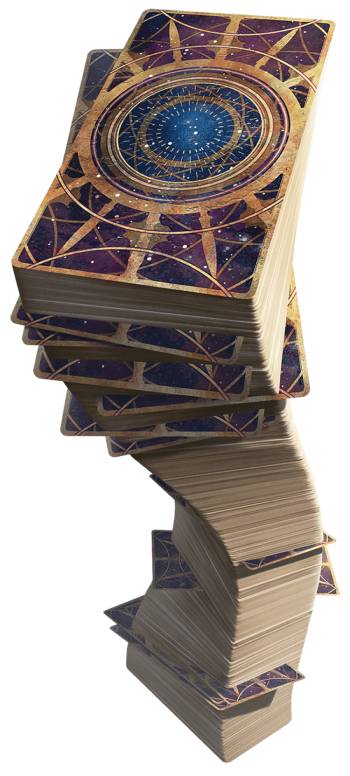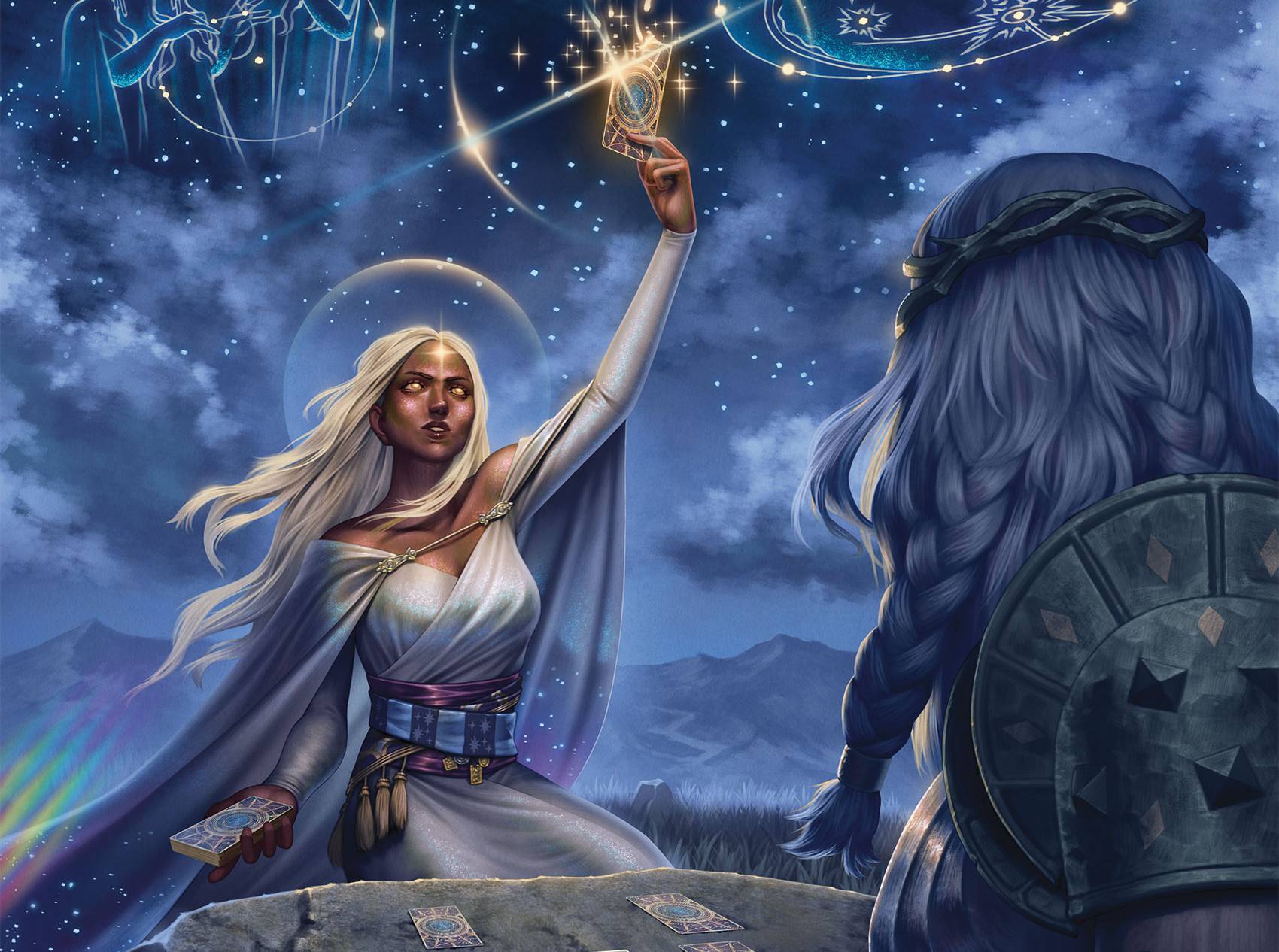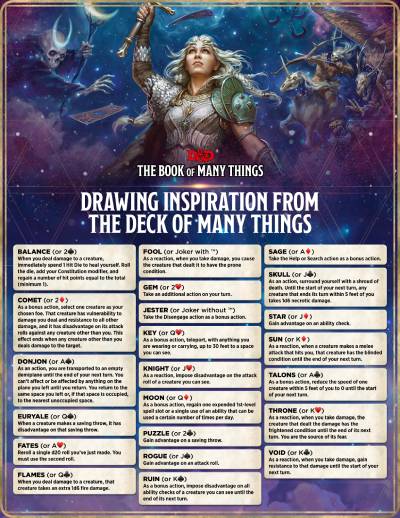The Deck of Many Things can be one of the most chaotic, exciting, and simultaneously devastating things to unleash into a D&D campaign. One of the biggest appeals of the Deck is the mystery box randomness that comes from drawing from a set of cards. But what if you want to incorporate that vibe more regularly into your game without the high stakes that come with the Deck itself? Well, The Book of Many Things has you covered!
Chapter 3 of The Book of Many Things, named after the Balance card, is chock-full of suggestions for ways that you can use the Deck or a standard deck of cards as a randomizer in your game. Among these are alternative rules for inspiration.
- Downloadable Handout: The Inspiration Deck
- How Inspiration Normally Works in D&D
- Playing With an Inspiration Deck
- Using the Inspiration Deck as a DM
Pick a Card, Any Card
One of the best parts of these alternate sets of rules is they’re designed to be used with any cards you might have, whether that’s the Deck of Many Things, tarroka cards, tarot cards, or a set of household playing cards. You could even use a set of cards from your favorite trading card game like Magic: The Gathering.
Downloadable Handout: The Inspiration Deck
Below, you can download a table that shows the effects for each of the 22 cards you’ll use in your inspiration deck.
| Card | Effect |
|---|---|
| Balance (or 2 ♠) | When you deal damage to a creature, immediately spend 1 Hit Die to heal yourself. Roll the die, add your Constitution modifier, and regain a number of hit points equal to the total (minimum 1). |
| Comet (or 2 ♦) | As a bonus action, select one creature as your chosen foe. That creature has vulnerability to damage you deal and resistance to all other damage, and it has disadvantage on its attack rolls against any creature other than you. This effect ends when any creature other than you deals damage to the target. |
| Donjon (or A ♠) | As an action, you are transported to an empty demiplane until the end of your next turn. You can’t affect or be affected by anything on the plane you left until you return. You return to the same space you left or, if that space is occupied, to the nearest unoccupied space. |
| Euryale (or Q ♠) | When a creature makes a saving throw, it has disadvantage on that saving throw. |
| Fates (or A ♥) | Reroll a single d20 roll you’ve just made. You must use the second roll. |
| Flames (or Q ♣) | When you deal damage to a creature, that creature takes an extra 1d6 fire damage. |
| Fool (or Joker with ™) |
As a reaction, when you take damage, you cause the creature that dealt it to have the prone condition. |
| Gem (or 2 ♥) | Take an additional action on your turn. |
| Jester (or Joker without ™) |
Take the Disengage action as a bonus action. |
| Key (or Q ♥) | As a bonus action, teleport, with anything you are wearing or carrying, up to 30 feet to a space you can see. |
| Knight (or J ♥) | As a reaction, impose disadvantage on the attack roll of a creature you can see. |
| Moon (or Q ♦) | As a bonus action, regain one expended 1st-level spell slot or a single use of an ability that can be used a certain number of times per day. |
| Puzzle (or 2 ♣) | Gain advantage on a saving throw. |
| Rogue (or J ♠) | Gain advantage on an attack roll. |
| Ruin (or K ♠) | As a bonus action, impose disadvantage on all ability checks of a creature you can see until the end of its next turn. |
| Sage (or A ♦) | Take the Help or Search action as a bonus action. |
| Skull (or J ♣) | As an action, surround yourself with a shroud of death. Until the start of your next turn, any creature that ends its turn within 5 feet of you takes 1d6 necrotic damage. |
| Star (or J ♦) | Gain advantage on an ability check. |
| Sun (or K ♦) | As a reaction, when a creature makes a melee attack that hits you, that creature has the blinded condition until the end of your next turn. |
| Talons (or A ♣) | As a bonus action, reduce the speed of one creature within 5 feet of you to 0 until the start of your next turn. |
| Throne (or K ♥) | As a reaction, when you take damage, the creature that dealt the damage has the frightened condition until the end of its next turn. You are the source of its fear. |
| Void (or K ♣) | As a reaction, when you take damage, gain resistance to that damage until the start of your next turn. |
How Inspiration Normally Works in D&D

In D&D, a Dungeon Master can choose to reward players with inspiration for playing their characters in a way that is true to the traits on their sheet, such as chasing their ideals or leaning into their flaws. A player whose character is a gambler might get inspiration for doubling down at a pivotal moment. An acolyte might get inspiration for roleplaying their character’s connection to their deity.
When you have inspiration, you can spend it during a game session to gain advantage when making an attack roll, saving throw, or ability check. Or you can choose to give your inspiration to another player at the table if you think they’ve done something to earn it.
Inspiration is a malleable concept in general. It is intended to enhance and celebrate the fun at the table. In the Dungeon Master’s Guide, variant rules exist for how to use inspiration. As a DM, I tend to be pretty generous with inspiration because I like encouraging roleplay. I also usually reward inspiration to new players at the start of their first session as a way of saying congrats on taking the dive! Likewise, I’ve had several DMs who will reward inspiration for solid puns made during the game. I do eventually get cut off when I’m at those tables.
Playing With an Inspiration Deck
The Book of Many Things offers rules for building and using an inspiration deck, an alternative system to the standard rules for inspiration. This is a deck of cards that utilizes either the complete Deck of Many Things or an equivalent 22-card deck.
To play with the inspiration deck, you will draw a number of cards equal to the number of players and place them face up on the table. When a player gains inspiration, they select one of the face up cards and keep it for later use. Each card has its own unique effect, which you’ll find in the above handout and Inspiration Cards table.
When a player uses their inspiration, they draw a new card face up for the communal hand and shuffle the used card back into the deck.
Inspiration, With a Twist
The inspiration deck can be an interesting alternative to the standard rules for inspiration, as it adds a layer of strategy. Now you might eye an appropriate and fun time to use a specific inspiration effect drawn from the deck. Although advantage is often useful, having the one-time option to use a bonus action to Disengage so you can move back and cast a spell could be clutch. Plus, having a physical card sitting with you at the table can serve as a good reminder to use your inspiration.
Using the Inspiration Deck as a DM

The Book of Many Things also offers rules for using the inspiration deck as the DM, and it plays into the fickle nature of the Deck of Many Things. Whenever a player uses their inspiration card, the DM gets to draw a card off the top. Rather than add it to the communal deck, the DM holds onto the card to use on behalf of one of the characters’ opponents at a later time.
This is definitely a system that requires a level of buy-in from the players. Some tables view inspiration purely as a reward and might not want to use inspiration if it means it might come back to haunt them. Other players might relish the double-bladed knife aspect of this option. Either way, it’s always good to discuss alternative rules with your players ahead of time and make sure those rules are conducive to the vibes at your table.
Hammer Away at Your Deck
The inspiration deck is just one of the new ways the Deck of Many Things can be incorporated into your D&D game. The Book of Many Things offers suggestions for other ways of using the Deck, such as to spark ideas for events along the course of a few days of travel, generate random encounters, or even come up with random NPCs to draw from when need be.
The Book of Many Things releases digitally on D&D Beyond on November 14. Order your copy today in the D&D Beyond marketplace!
Riley Silverman (@rileyjsilverman) is a contributing writer to D&D Beyond, Nerdist, and SYFY Wire. She DMs the Theros-set Dice Ex Machina for the Saving Throw Show, and has been a player on the Wizards of the Coast-sponsored The Broken Pact. Riley also played as Braga in the official tabletop adaptation of the Rat Queens comic for HyperRPG, and currently plays as The Doctor on the Doctor Who RPG podcast The Game of Rassilon. She currently lives in Los Angeles.









-
View User Profile
-
Send Message
Posted Nov 10, 2023Huh, this is really interesting.
-
View User Profile
-
Send Message
Posted Nov 10, 20232nd and I agree
-
View User Profile
-
Send Message
Posted Nov 10, 2023This'll be really useful! I'm planning to gift inspiration to my players if they can name the battle music I'm using for my campaign
-
View User Profile
-
Send Message
Posted Nov 11, 20234th and pretty cool
-
View User Profile
-
Send Message
Posted Nov 11, 2023That might be something my player would be interest in
-
View User Profile
-
Send Message
Posted Nov 11, 2023I love this idea and I haven't come across it in the book yet so I love that attention was called to it.
-
View User Profile
-
Send Message
Posted Nov 11, 2023I'm actually in the first ten comments!
-
View User Profile
-
Send Message
Posted Nov 11, 2023That is cool I would be interested in it and 9th
-
View User Profile
-
Send Message
Posted Nov 11, 2023They renamed them to the puzzle and sage.
-
View User Profile
-
Send Message
Posted Nov 11, 2023Curious to find out from anyone if there is a tool for online games which can simulate drawing from a Deck of Many Things? I have an older, physical deck, but I would like to ask how other players/DMs have used a Deck of Many Things through online play?
-
View User Profile
-
Send Message
Posted Nov 11, 2023Will be using this tonight. My players are skittish about the Deck of Many Things, so I'm going to mess with them just a little before telling them that these are inspiration cards
Edit: The players loved these cards. They actually remembered they had inspiration and used them. These will be a new regular part of our games.
-
View User Profile
-
Send Message
Posted Nov 11, 2023You could probably do something within Foundry's card system to make them the Deck of Many Things cards, or find some online tool for a custom deck of cards to draw from
-
View User Profile
-
Send Message
Posted Nov 12, 2023I skip all this by giving advantage for good playing. People are already upset that the game is unbalanced. This does not help
-
View User Profile
-
Send Message
Posted Nov 12, 2023Playing with the idea of using this deck as a supplement or replacement to a bard's inspiration. Maybe the bard can choose to throw cards to his allies Gambit style and the card can either be the normal inspiration die buff or one of these inspiration deck cards. And maybe at much higher levels, the bard can add the normal inspiration with a random card ability - similar to the wild magic surge for a sorcerer. A "Wild Card Bard".
-
View User Profile
-
Send Message
Posted Nov 12, 2023Were you able to download this? I'm only to right-click as select Save Image As
-
View User Profile
-
Send Message
Posted Nov 13, 2023I love this, using it on my next session, will see how I can balance it out if it proves to be too strong. Then again, the DM getting inspiration is a rad idea.
-
View User Profile
-
Send Message
Posted Nov 13, 2023When you say: "download the cards" we imagine real CARDS, not a TABLE... Fix the title, because it's false advertising.
-
View User Profile
-
Send Message
Posted Nov 13, 2023I already made my own with Tarokka deck it a very evil deck
-
View User Profile
-
Send Message
Posted Nov 13, 2023Intriguing for sure.
-
View User Profile
-
Send Message
Posted Nov 13, 2023Hi
In roll 20 you can make your own decks. I made a deck of the 22 cards. You can make your own or there is a option to by graphics from Keltic Studio. I use cards quite a bit in Roll20. You can deal them to the player. I have a standard card deck and a Tarot deck in most of my games. (Response to SirNotAppearing...)